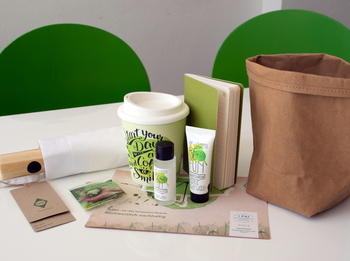
What does sustainability have to do with the advertising materials field?
 Isn't sustainability something for eco-warriors and tree-huggers? This cliché has long since outlived its usefulness. "Green thinking" is becoming ever more prevalent. Sustainability isn't just the preserve of the green lobby: if we're to have a future worth living in, it's actually an obligation as well as being an ever more significant competitive factor for companies.
Isn't sustainability something for eco-warriors and tree-huggers? This cliché has long since outlived its usefulness. "Green thinking" is becoming ever more prevalent. Sustainability isn't just the preserve of the green lobby: if we're to have a future worth living in, it's actually an obligation as well as being an ever more significant competitive factor for companies.Cybergroup has sought the opinion of its partners and asked them what sustainability means for suppliers. Adopting a strategy that includes environmental awareness and social standards can win back and keep the trust of customers. Conversely, this same trust will quickly be lost if critical consumers are bombarded with cheaply produced and badly conceived advertising materials. Today's "Lohas" (people living a "lifestyle of health and sustainability") are a sought-after target group: they earn good money, often have children, and are well informed and sensitive when it comes to avoiding waste.
Advertising materials always reflect current trends and societal issues, meaning that the advertising materials industry is increasingly getting to grips with sustainable products and processes. Although sustainability and advertising materials were still mutually exclusive concepts until just a few years ago, an awful lot has changed since then. One key trend is the movement away from disposable items toward genuine promotional gifts. The best approach is to ditch the scattergun approach in favour of higher quality products which last and are happily used for longer by consumers, meaning that they are also seen more frequently. This is a good way of achieving a sustainability effect twice over: both environmentally and in terms of the client's advertising budget.
The most obvious way of making a haptic product sustainable is to use environmentally friendly materials in its construction. Producers often refer back to "old" natural materials, such as wood, bamboo, paper or cotton. With natural materials, what matters alongside sustainable production, such as FSC certification for wood and organic cotton farming, is also the import regulations in force in the target countries. Parallel and ongoing developments in recent years have seen the repeated emergence of exciting alternative materials such as vegan leather made of paper, paper from cut grass or apple cores, plastic derived from corn or bamboo, and more besides. Although some of these ideas require critical scrutiny, they no doubt send a signal and are a step in the right direction. Sustainability doesn't have to come at the expense of design and can even be cool. For instance, these materials often go hand-in-hand with completely new product ideas.
As the issue runs like a thread all the way along the value chain, social and ecological criteria which can be monitored, guaranteed and verified need to be fulfilled during production too with the aid of a whole raft of quality seals, standards and initiatives. These include membership of the BSCI, to which Cybergroup also belongs. Consumers are familiar especially with names like the Fair Trade label, the Global Organic Textile Standard (GOTS) and, of course, the organic quality seal. There are also sustainable possibilities for the reduction of waste and CO2 emissions in the subsequent choice of packaging and despatch options.
But, alongside all these aspects, there is one thing the product simply has to have: A benefit for the consumer. After all, even if a product is made of environmentally friendly materials and sustainably produced, it can't be sustainable - either for the consumer or the advertiser - if it is used once and then thrown away.
The final decision on whether to buy a product is made at the point of purchase, where the price is still usually the decisive factor. However, many customers have now recognised that consumers have become more critical and no longer want any old throwaway item. So they buy in line with their budget rather than in bulk: Buying fewer items at a higher individual price can be worthwhile, because higher quality items have a longer-term and more intensive promotional effect.
If sustainability is going to be put into practice with any consistency, it must relate to the entire value chain, which just goes to show just how complex the issue is. Comprehensive information can be found on specialist websites such as eco-promo.de; there are of course a lot of informative articles and ideas at WerbeART (in German only) and in the WA, which has issued its own very interesting special on the topic. Moreover, one of the upcoming issues will once again be dealing with the subject in greater detail. Cybergroup will also be presenting product ideas relevant to the topic in July, the sustainability month.




